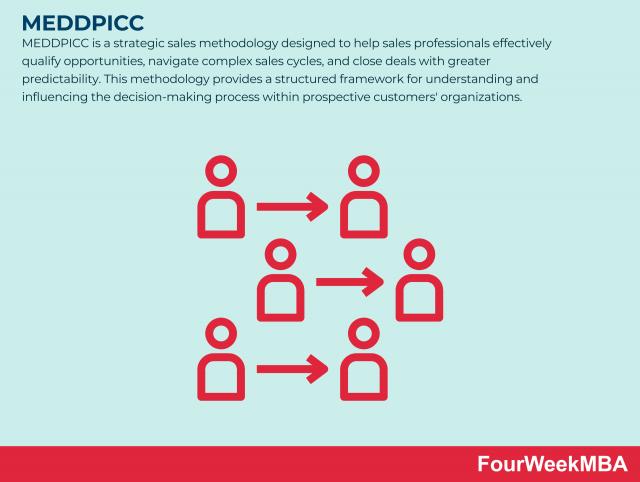MEDDPICC is a strategic sales Methodology designed to help Sales Professionals effectively qualify opportunities, navigate complex sales cycles, and close deals with greater predictability. This methodology provides a structured framework for understanding and influencing the decision-making process within prospective customers’ organizations.
Components of MEDDPICC Methodology
1. Metrics
Metrics represent the quantifiable measures used to evaluate the success and impact of a potential solution within the customer’s organization. These metrics can include financial metrics such as return on investment (ROI), cost savings, revenue growth, or efficiency gains, as well as non-financial metrics such as increased productivity, reduced risk, or improved customer satisfaction.
2. Economic Buyer
The Economic Buyer is the individual or group within the customer’s organization who has the authority and budgetary responsibility to make purchasing decisions. Identifying and engaging with the Economic Buyer early in the sales process is critical to gaining buy-in and advancing the opportunity.
3. Decision Criteria
Decision Criteria represent the key factors and considerations that influence the customer’s decision-making process. These criteria may include business requirements, technical specifications, regulatory compliance, competitive differentiation, and strategic alignment with organizational goals.
4. Decision Process
The Decision Process outlines the steps and stages involved in the customer’s decision-making journey, from initial awareness and evaluation of potential solutions to final selection and implementation. Understanding the Decision Process allows sales professionals to anticipate potential roadblocks, address concerns, and navigate the sales cycle effectively.
5. Paper Process
The Paper Process refers to the administrative and procedural steps required to finalize and formalize the purchase decision, including contract negotiation, legal review, procurement approvals, and financial considerations. Understanding the Paper Process enables sales professionals to streamline the closing process and expedite deal closure.
6. Implicate Pain
Implicate Pain involves identifying and articulating the customer’s underlying challenges, problems, or pain points that create a compelling need for a solution. By understanding the root causes of the customer’s pain, sales professionals can position their solution as the most effective means of addressing these challenges and delivering tangible value.
7. Champion
The Champion is an internal advocate or sponsor within the customer’s organization who actively supports and promotes the sales opportunity. Cultivating a strong Champion relationship is critical to gaining access to key stakeholders, navigating internal politics, and overcoming obstacles throughout the sales process.
Application of MEDDPICC Methodology
1. Qualification
MEDDPICC provides a systematic approach to qualifying sales opportunities by assessing the customer’s readiness, willingness, and ability to purchase. By evaluating key components such as Metrics, Economic Buyer, Decision Criteria, and Decision Process, sales professionals can determine whether an opportunity aligns with their solution and merits further investment of time and resources.
2. Opportunity Management
MEDDPICC helps sales professionals effectively manage sales opportunities by providing a structured framework for understanding and influencing the customer’s decision-making process. By addressing each component of the methodology, sales professionals can identify and address potential obstacles, mitigate risks, and accelerate deal closure.
3. Forecasting
MEDDPICC improves the accuracy and reliability of sales forecasting by providing visibility into the key factors and considerations driving the customer’s decision-making process. By tracking progress against metrics, engaging with the Economic Buyer, understanding decision criteria, and monitoring the decision process, sales professionals can more accurately predict the likelihood and timing of deal closure.
Significance of MEDDPICC Methodology
1. Predictability
MEDDPICC enhances the predictability of sales outcomes by providing a structured and systematic approach to opportunity qualification and management. By rigorously assessing key components such as Metrics, Economic Buyer, Decision Criteria, and Decision Process, sales professionals can identify potential risks and opportunities early in the sales cycle and take proactive steps to influence the outcome.
2. Control
MEDDPICC gives sales professionals greater control over the sales process by providing visibility into the customer’s decision-making journey and enabling them to proactively address potential obstacles and objections. By understanding the customer’s pain points, engaging with key stakeholders, and navigating the Paper Process, sales professionals can maintain momentum and drive deal closure.
3. Differentiation
MEDDPICC enables sales professionals to differentiate themselves from competitors by demonstrating a deeper understanding of the customer’s business challenges, needs, and priorities. By implicate pain, engaging with the Economic Buyer, and aligning their solution with the customer’s decision criteria, sales professionals can position themselves as trusted advisors and preferred partners for their customers.
Implementation and Considerations
1. Training and Enablement
Successful implementation of the Meddpicc Methodology requires training and enablement for sales professionals on the key components and principles of the methodology. Training programs should focus on developing skills in opportunity qualification, customer engagement, value articulation, and objection handling.
2. Adoption and Consistency
Consistent adoption of the MEDDPICC Methodology across the sales organization is essential for its effectiveness. Sales leaders should provide guidance, support, and reinforcement to ensure that sales professionals embrace and apply the methodology consistently in their sales activities.
3. Continuous Improvement
The MEDDPICC Methodology should be continually refined and optimized based on feedback and insights from sales professionals and customers. Sales leaders should encourage a culture of continuous improvement, experimentation, and learning to adapt the methodology to evolving market conditions and customer needs.
Conclusion
The MEDDPICC Methodology provides a structured and systematic approach to qualifying sales opportunities, navigating complex sales cycles, and closing deals with greater predictability. By addressing key components such as Metrics, Economic Buyer, Decision Criteria, and Decision Process, sales professionals can gain deeper insights into the customer’s decision-making process, overcome obstacles, and accelerate deal closure. As businesses strive to drive revenue growth, improve sales effectiveness, and differentiate themselves in competitive markets, the MEDDPICC Methodology remains a valuable tool for sales organizations seeking to achieve their growth objectives and drive long-term success. Through its emphasis on qualification, opportunity management, predictability, and control, the MEDDPICC Methodology empowers sales professionals to effectively engage with customers, drive value, and win more deals.
Related Business Concepts
Business Development
Sales vs. Marketing
Sales Cycle
RevOps
BATNA
WATNA
ZOPA
Revenue Modeling
Customer Experience Map
AIDA Model
Social Selling
CHAMP Methodology
BANT Sales Process
MEDDIC Sales Process
STP Marketing
Sales Funnels vs. Flywheels
Pirate Metrics
Bootstrapping

